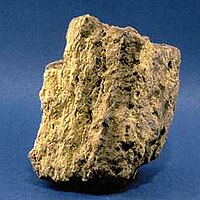
Photo from wikipedia
Abstract The formation of sandstone-style uranium deposits are significantly controlled by the latest tectonic uplift events, especially those generated in an open system by the infiltration of meteoritic water. This… Click to show full abstract
Abstract The formation of sandstone-style uranium deposits are significantly controlled by the latest tectonic uplift events, especially those generated in an open system by the infiltration of meteoritic water. This study explores the spatiotemporal relationship between global Miocene tectonics and sandstone-style uranium deposits to evaluate the link between tectonic uplift and metallogenic ages. In general, modern landforms were shaped by diverse global tectonic events that began in the Middle and Late Miocene. This includes the formation of continental-scale faults and fold belts, including the uplift of the three broadly contemporaneous ranges, the Alpine–Himalayan Belt, the Cordillera, and the East African Rift. These events were accompanied by intense magmatic activity, as well as an increase in the spreading rates of oceanic ridges and higher sedimentation rates in the Pacific, Indian, and Atlantic oceans. Modern global climate patterns are a direct consequence of these Miocene tectonic events. Studies on sandstone-style uranium deposits report that though their stratigraphic ages extend from the Proterozoic to the Cenozoic, they notably occur from the Late Mesozoic to the Neogene. Uranium mineralization ages are concentrated between 20 and 0.1 Ma, clustering mainly in the Miocene although remobilizations are known to have occurred subsequently, some even in the Holocene. Global tectonics in the Miocene, between 20 and 5 Ma, resulting in the regional uplift of mountain ranges and continental tilts, may have exerted significant control over the migration directions of uranium-bearing fluids that formed these sandstone-style uranium deposits. Climate patterns in the Miocene, specifically subtropical high-pressure belts on both sides of the equator controlled the creation of arid and semi-arid areas, creating characteristic rainfall patterns which would also have influenced the spatial distribution of these uranium deposits. Thus, the spatiotemporal characteristics of most sandstone-style uranium deposits in the world were controlled by global tectonics in the Miocene that uplifted mountain ranges and tilted continents, generating subtropical high-pressure belts and the Asian high pressure region. In addition to new ideas adding greater research value to the study of global sandstone-style uranium mineralization, this paper also provides a new exploration indicator for sandstone-style uranium deposits.
Journal Title: Ore Geology Reviews
Year Published: 2019
Link to full text (if available)
Share on Social Media: Sign Up to like & get
recommendations!